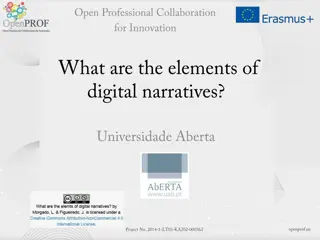Exploring Narrative Choices in Storytelling
Writers can shape stories by choosing whose perspective to follow and whose voice to narrate through in first or third person. Through excerpts from popular books like "Millions" by Frank Cottrell Boyce, "The Other Side of Truth" by Beverly Naidoo, and "Private Peaceful" by Michael Morpurgo, we witness different characters' experiences and emotions, providing insight into their thoughts and actions.
Download Presentation

Please find below an Image/Link to download the presentation.
The content on the website is provided AS IS for your information and personal use only. It may not be sold, licensed, or shared on other websites without obtaining consent from the author. Download presentation by click this link. If you encounter any issues during the download, it is possible that the publisher has removed the file from their server.
E N D
Presentation Transcript
Narrative Choices Narrative Viewpoint and Voice When we read, we see images in our mind and hear a voice in our heads. Writers can choose whose eyes we see through and whose voice we hear telling the story. Read the extracts on the next 2 slides and decide: Whose eyes do we see through? What does their voice sound like? How do you react?
In Millions by Frank Cottrell Boyce, Damian hides the stolen money in the loft in his old house, which he thinks is empty . I was just pushing the lower half of the ladder back up when I heard it. There was someone at the front door. I held my breath. It was OK. They couldn t get in. I slid my hand into my pocket to make sure the key was still there. It wasn t. I d left it in the front door. I could hear it turning in the lock now. I raced back up the ladder and hauled it after me. When I reached down to pull the hatch back up, I could hear someone coming up the stairs. I quickly pulled the hatch back into place and scrabbled over to the water tank, holding my breath.
In The Other Side of Truth by Beverly Naidoo, the story starts with a flashback to a terrible event Sade is slipping her English book into her schoolbag when Mama screams. Two sharp cracks splinter the air. She hears her father s fierce cry, rising, falling. No! No! The revving of a car and skidding of tyres smother his voice. Her bag topples from the bed, spilling books, pen and pencil to the floor. She races to the verandah, pushing past Femi in the doorway. His body is wooden with fright. Mama mi? she whispers. Papa is kneeling in the driveway, Mama partly curled up against him. One bare leg stretches out in front of her. His strong hands grip her, trying to halt the growing scarlet monster. But it has already spread down her bright white nurse s uniform. It stains the earth around them. A few seconds, that is all. Later, it will always seem much longer.
In Private Peaceful by Michael Morpurgo, the narrator is Tommo, Charlie s brother. He tells the story in flashback, looking back over his life with his brother, who faces a firing squad in the First World War. Here is the voice of Tommo as an eighteen-year-old soldier: I want to try to remember everything, just as it was, just as it happened. I ve had nearly eighteen years of yesterdays and tomorrows, and tonight I must remember as many of them as I can. I want tonight to be long, long as my life, not filled with fleeting dreams that rush me on towards dawn. And here is the voice of Tommo as a child starting school: Charlie is taking me by the hand, leading me because he knows I don t want to go. I ve never worn a collar before and it s choking me. My boots are strange and heavy on my feet. My heart is heavy too, because I dread what I am going to. Charlie has told me often how terrible this school-place is: about Mr Munnings and his raging tempers and the long whipping cane he hangs on the wall above his desk. I don t want to go with Charlie. I don t want to go to school.
So, writers can choose. First person narrative: Charlie is taking me by the hand. I don t want to go to school. Third person narrative: Sade is slipping her English book into her schoolbag when Mama screams.
Past tense: There was someone at the front door. I held my breath. Present tense: My boots are strange and heavy on my feet.
Writers can tell a story In the order in which events happen Through flashback to events that happened earlier From one viewpoint or more than one
To think about: What are some advantages of telling a story in the first person? What are some disadvantages? Why might you choose the present tense to tell a story?
To try: Charlie is taking me by the hand, leading me because he knows I don t want to go. I ve never worn a collar before and it s choking me. My boots are strange and heavy on my feet. My heart is heavy too, because I dread what I am going to. Charlie has told me often how terrible this school-place is: about Mr Munnings and his raging tempers and the long whipping cane he hangs on the wall above his desk. I don t want to go with Charlie. I don t want to go to school. CHANGE Present tense to past tense First person to third person Write this scene from Mr Munnings viewpoint, as he watches Charlie dragging Tommo to school. Which version do you like the best?























